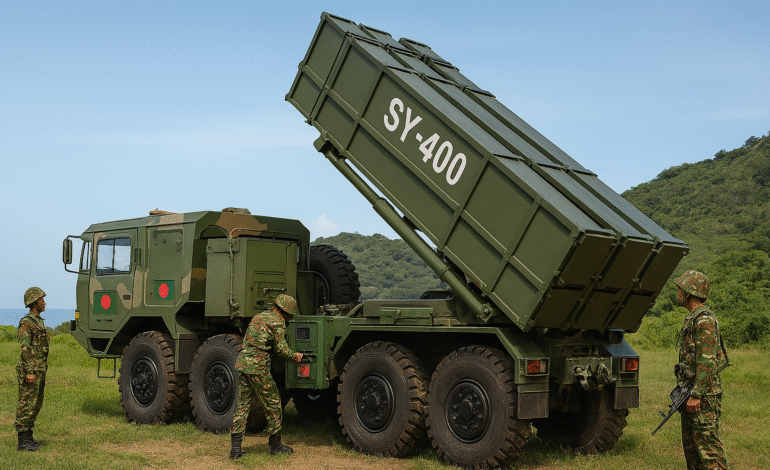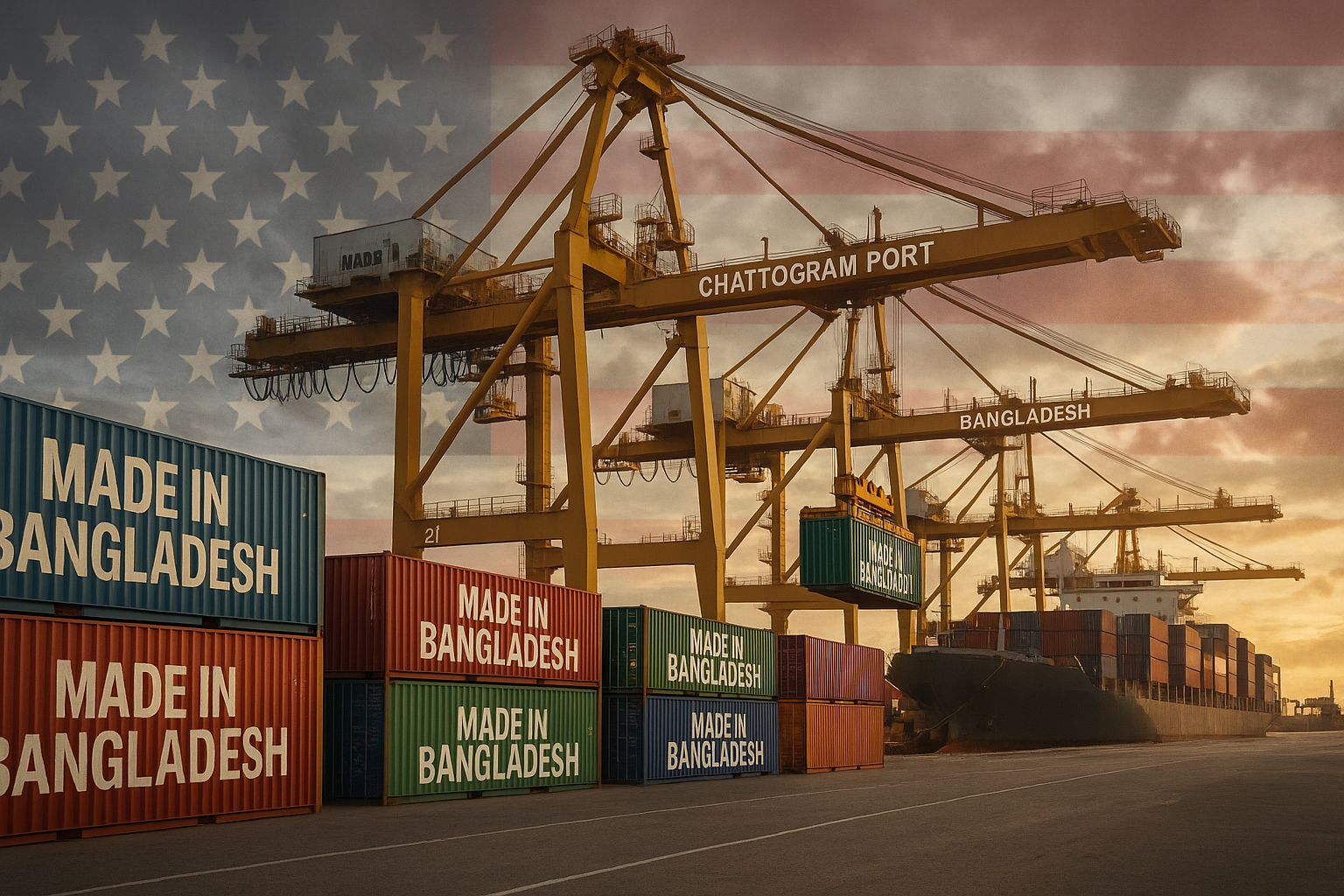Bangladesh to equip SY-400 Missile System From China

Bangladesh to equip SY-400 Missile System From China: A Strategic Leap in South Asian Defence
Bangladesh’s recent order and entry into service of the SY-400 short-range ballistic missile system mark one of the most consequential military procurements in its history. The Bangladesh SY-400 acquisition signals Dhaka’s intent to modernise its armed forces, expand strike capabilities, and play a more active role in regional deterrence. While rooted in national defence priorities, the deal has clear global implications—touching on China’s arms export strategy, shifting power dynamics in the Bay of Bengal, and emerging missile proliferation patterns worldwide.
What the Deal Entails: Technical Features and Scope
The Bangladesh SY-400 acquisition involves the Chinese-built modular SRBM system deployed by the Bangladeshi Army under its Forces Goal 2030 roadmap. Developed by China Aerospace Science and Industry Corporation (CASIC), the SY-400 system features 8 × 8 transporter-erector-launcher vehicles capable of carrying containerised missiles ready for vertical launch.
Key technical features include:
A reported range of up to 280 kilometres, enabling Bangladesh to engage high-value military targets beyond previous artillery limits.
Warhead options including high-explosive fragmentation, sub-munitions or cluster payloads; missiles weigh between 900 and 1,300 kg depending on variant.
Hybrid guidance using inertial navigation plus satellite augmentation (China’s BeiDou or GPS), terminal seekers (optical/radar) and reported Circular Error Probable (CEP) of 30-50 metres in optimal conditions.
High mobility shoot-and-scoot capability, ready-to-launch in under 10 minutes, enabling rapid response and enhanced survivability.
The cost-effectiveness of the Bangladesh SY-400 acquisition is also noteworthy. At an estimated price tag of US $10–15 million per battery (versus higher-cost equivalents in Western systems), the system offers an affordable leap in capability for a fiscally restrained defence budget.
Regional Significance: Bay of Bengal and South Asian Security
The Bangladesh SY-400 acquisition is not simply a bilateral purchase but a signal in the shifting security architecture of South Asia and the Bay of Bengal region. For decades Bangladesh relied mainly on short-range rocket and artillery systems with limited reach. With this acquisition, Dhaka closes a key capability gap and enhances its deterrence envelope.
Against neighbouring Myanmar, which acquired SY-400 systems earlier, Bangladesh now restores a degree of parity and raises the cost of any coercive strategy aimed at its territorial or strategic assets.
In relation to India, while bilateral ties are largely cooperative, the Bangladesh SY-400 acquisition alters the strategic calculus in the sub-region. With potential coverage of parts of India’s northeastern sector from Bangladesh’s missile range, New Delhi is prompted to reassess deterrence and military posture in its border states.
Furthermore, the acquisition underscores China’s expanding arms diplomacy and its strategic foothold in South Asia. By supplying high-end missile systems to Bangladesh, Beijing strengthens military ties, influences defence doctrine, and increases dependence on Chinese logistics and supply chains. The deal thus has implications for global arms-export controls and power-projection beyond the immediate region.
Global Implications: Arms Exports, Deterrence and Strategic Autonomy
From a global perspective, the Bangladesh SY-400 acquisition illustrates several trends:
1. Emerging-market access to precision munitions – The availability of long-range, accurate missile systems to states like Bangladesh highlights growing diffusion of strike technology, once the domain of major powers.
2. Cost-effective deterrence – The ability to buy modular, capable missiles at relatively low cost allows smaller states to shift from purely defensive postures to credible deterrence roles.
3. China’s arms export strategy – By supplying the SY-400, China continues to position itself as a major global arms supplier, particularly to developing states. This has implications for Western arms-control regimes and alliance-dynamics.
4. Regional strategic balance – Bangladesh’s move affects not just bilateral relations but regional power architecture, particularly around maritime chokepoints, shared borders and strategic depth in South Asia.
In the broader context of global security, the deal provokes questions about missile proliferation, command-and-control safety, transparency and whether smaller states acquiring such capabilities might destabilise regional peace or lead to new arms races.
Bangladesh’s Strategic Autonomy and Forces Goal 2030
The Bangladesh SY-400 acquisition aligns with the country’s long-term defence modernisation plan, known as Forces Goal 2030. Under this roadmap, Bangladesh aims to build a mobile, technologically integrated tri-service military capable of ensuring national security and contributing to regional stability.
The missile system fills a key capability gap, giving Bangladesh strategic reach, precision strike ability and a deterrent that complements its air force, navy and ground forces. Local analysts highlight that the acquisition is as much about strategic messaging as capability enhancement—it signals Bangladesh’s readiness to protect its interests and maintain credible defence posture.
At the same time, Bangladesh’s defence budget (about 1.2 % of GDP as reported for 2025) requires cost-efficient procurement models. The Bangladesh SY-400 acquisition demonstrates how Dhaka uses smart procurement, Chinese financing/technology transfer, and modular systems to achieve modernization without overextending fiscal limits.
Challenges and Considerations Ahead
While the Bangladesh SY-400 acquisition is significant, the deployment and operationalisation pose challenges:
Integration: Introducing a complex missile system requires new doctrines, training, command-and-control networks, intelligence/surveillance support and logistical infrastructure.
Escalation risk: Although Dhaka asserts the system is defensive, its range and precision raise questions about regional perceptions, unintended escalation and arms race dynamics.
Maintenance and sustainability: Reliance on foreign supply chains (primarily Chinese) for spare parts and support can create dependencies.
Arms control and transparency: The growing availability of long-range systems in South Asia may push regional forums (e.g., SAARC, BIMSTEC) to consider missile transparency and confidence-building measures.
Budgetary constraints: While initial acquisition costs may be affordable, long-term investment in training, maintenance and upgrades remains significant.
How Bangladesh manages these challenges will determine whether the SY-400 becomes a transformational capability or a costly procurement burden.
A Milestone with Global Resonance
The Bangladesh SY-400 acquisition represents a strategic milestone for Dhaka, marking its transition from a defensive posture to one of enhanced deterrence and regional influence. The deal also has broader global significance, highlighting changing arms-export patterns, the diffusion of precision missile technology to emerging states and the evolving power dynamics in the Indo-Pacific region.
While numerous risks and operational challenges remain, Bangladesh’s move offers a model of how smaller states can judiciously upgrade defence capabilities within budgetary constraints, seek strategic autonomy and engage global partners like China in modernisation. In doing so, the Bangladesh SY-400 acquisition will likely be studied by allied defence planners, arms-control scholars and regional analysts as a case study in 21st-century missile proliferation and strategic balancing.







